John Z. DeLorean, the eccentric but indisputably brilliant father of the 1964 GTO, also had a vision for a sexy, low-slung Pontiac two-seater. He even had a prototype built – the XP-833 Banshee. GM management, however, considered the proposed Pontiac coupe/roadster a heretical threat to the primacy of the Chevy Corvette and the Banshee was discretely shelved, along with DeLorean himself a few years later.
But the spirit of the Banshee concept would linger within the halls of Pontiac into the ’70s — dormant, but far from exorcized. In the early ’80s, it was reincarnated in the form of an altogether new mid-engined, space-framed and polymer bodied two-seater called Fiero. 
It was meant to be an affordable exotic – an American Porsche or Lotus. Unfortunately, other than the car’s mid-engine layout, exterior styling and unusual dent-resistant composite body panels, much of the original vision for the car never saw production. To save money, GM management insisted on the use of un-exotic chassis and drivetrain components – including a front suspension similar to that found underneath the front end of the Chevy Chevette, the lowest-priced car in GM’s lineup at the time – and a rear suspension identical to that of a Chevy Citation, Chevy’s next-lowest-cost economy car.
There was also a nothing-special 2.5 liter four cylinder “Iron Duke” engine under the hood that only made 90 horsepower. This engine was based on the last Pontiac V8 engine, the 301 – and both were designed primarily to be light-weight and fuel-efficient. 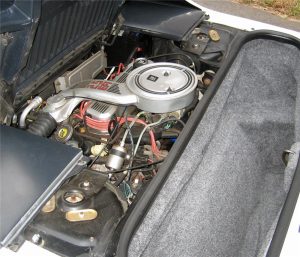
Still, what eventually saw the light of day in 1984 was a very sharp-looking car that was initially very popular with buyers -136,840 of whom who were willing to overlook its weaknesses because of its attractive styling, fun personality and low price.
The ’84 Fiero was was also lauded by Car and Driver magazine as one of that year’s Ten Best new cars.
A modified ’84 Fiero even beat out the also-new Chevy Corvette for pace car duty at the Indianapolis 500 that year.
Production versions of the Fiero pace car were offered for sale with the same “aero” snub nose treatment and bodywork featured on the pace car – but sans the specially-built “super duty” 200-plus horsepower engines used in the real pace cars. Only 2,000 ’84 Indy 500 pace car replicas were manufactured – all of them in special white paint with powder-coated “aero” wheels, silver leather and red two-tone interiors, quad exhaust tips and stereo speakers built into the headrests of the seats. The throttle body-injected 2.5 liter “Iron Duke” four was mechanically the same as in standard Fieros, but got dressed up with red spark plug wires and silver/black air cleaner and rocker cover. 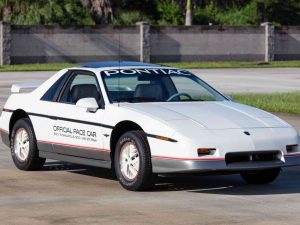
The pace car package was not cheap, adding almost $5,000 to the base price of a 2M4 Fiero – boosting it from around $9,500 to nearly $15,000 in 1984 dollars; this latter being the equivalent of about $43,000 in 2022 dollars.
For the second-year follow-up, Pontiac addressed the Fiero’s power problem by offering a new V6 option in the SE and GT trims. This engine developed 140 hp, a significant uptick over the output of the base 2.5 liter engine. Gradually, the car was transforming into the sort of car envisioned by its primary designer, Hulki Aldikacti. Ironically, despite these improvements, sales fell through the floor to just 76,371 units – an alarming turn, insofar as GM upper management was concerned. Apparently, problems with the first-year Fieros — including a tendency for the engine to catch fire – had soured many buyers on the car. Word had also gotten out about the Fiero’s less-than-sexy Chevette-sourced chassis bits, severely undermining its sports car credibility.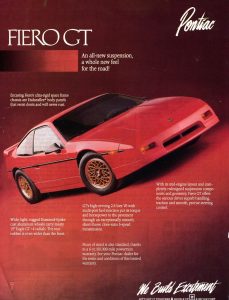
It was history repeating itself, in a different way.
Back in the late 1950s, GM launched the Chevy Corvair – which was meant to be a low-priced but highly innovative economy car. It had a rear-mounted, air-cooled engine and sporty styling. It got into trouble because of just that. Many buyers expected more from the car than GM had built into it. The Poorsche – as some called it – had a tendency to lift-throttle oversteer when maneuvered aggressively by novice drivers, especially if the tire inflation pressure recommendations were ignored. This wasn’t a problem for Porsches – which shared a similar drivetrain layout and had similar tendencies – because most people who could afford Porsches weren’t novices. VW Beetles also had a similar layout – but were so underpowered it was hard to get them going fast enough for lift-throttle oversteer.
But the Corvair – which had nearly twice the power of a Beetle and cost a third as much as a Porsche – got into the hands of a lot of people looking to go fast who didn’t have the skills to handle it. The “public safety” lawyer Ralph Nader made a living off his savaging of the Corvair as being “unsafe at any speed.”
With the Fiero, it was a case of trying to attract drivers who wanted to go fast – in the straights as well as the curves – and disappointing them while not attracting a sufficiency of buyers just looking for an economical little commuter car.
Still, the Fiero had managed a good start – especially in view of the way it was hobbled by upper management cost-cutting.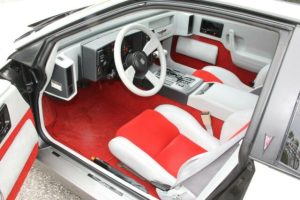
Pontiac managers wanted to introduce a turbocharged V6 with a five speed manual rather than the four speed unit without overdrive that was initially used, along with a totally revised suspension unique to the Fiero that would have made it a legitimate sports car rather than a sporty-looking commuter car. These changes also might have turned the Fiero (like the Banshee) into a real threat to the Corvette – and that may explain why they never got approved. With sales dropping so precipitously after just one year on the market, it became even harder for advocates with Pontiac to make the case for upgrading the car.
Still, some things did manage to get through the pipeline, eventually. These included the five speed Getrag-sourced manual transmission the car ought to have come with from the beginning, as well as a new fastback bodystyle (for ’86) and an available 2.8 liter V6. These changes somewhat salved the sales droop of the previous year, with a noticeable tick upward to 83,974 cars sold. 
But ’86 would prove to be the high water mark for the Fiero.
The mostly carryover ’87 model (which received some minor tweaks, including distributorless ignition and a new cylinder head for the base four cylinder engine that resulted in a slight increase in output to 98 hp) never came close to matching the sales performance of the previous year.
Only 46,581 found homes – a near-50 percent plummet over the prior year. It was clear the Fiero was in serious trouble.
A desperate Hail Mary pass was attempted for 1988 – the final (and arguably, best) year for the Fiero. At last – literally – the car got a credible sports car all-independent suspension system very similar to designs then in use by Lotus (which GM had just acquired the rights to). A new Formula model was offered – along with much-improved vented four-wheel-disc brakes.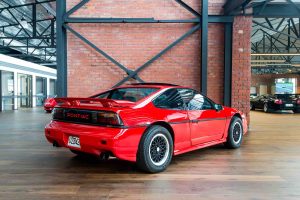
The ’88 GT lived up to the promise of 1984. Straight line performance was very good (15 second quarter miles times were possible) and handling was excellent. Everyone who drove the car agreed it was as fun to drive as the original had looked fun to drive.
Had this car been introduced four years earlier, the Fiero might have saved Pontiac, which eventually also went to sleep with the fishes – arguably because, post-Fiero, it had nothing Pontiac to offer except the badge. The Fiero was the last Pontiac-specific car that wasn’t re-sold under other GM badges. Its demise heralded the eventual demise of the Pontiac badge – which sharp eyed observers could see was itself in trouble years before that happened.
The division had already lost the Firebird and Trans-Am, two of its former hot-sellers, which (after the 1981 model year) had been turned into restyled Camaros sold under Pontiac badges, without any Pontiac mechanicals. The rest of the lineup was also the same. Only the Fiero was different.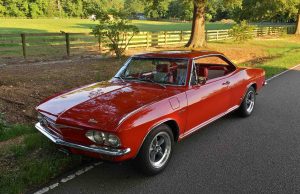
But it was too little, too late – a common problem with General Motors. Other examples include the second-generation 1965-’69 Corvair – which was restyled and re-engineered to be the sporty car the original ’59-64 model wasn’t – the Cadillac Allante of the early ’90s, which was an ok car the last year they made it.
Despite the major improvements, the market had turned for good against the “proud one” – as the Fiero was also known. Sales ebbed again, down to 39,571 – of which about half were V6 GTs or Formulas. 
This was the banshee – in the literal meaning of the word, which in old Irish means a shrieking harbinger of imminent death.
Although there were plans in the works for a second generation Fiero – possibly with a new DOHC engine – things never got further along than a styling buck/advanced prototype which was never shown to the public until many years after the Fiero’s cancellation after the ’88 model year. It’s too bad potential buyers never saw it – because the prospect of a DOHC or turbo V6 Fiero with more than 200hp (and even a possible V8 option) might very well have jump-started enough enthusiasm for the car to persuade GM management not to pull the plug.
But GM management GM had lost faith in the car – while GM’s Chevy division probably cared very much about the possibility of a Pontiac competitor that might have been faster and better handling – as well as less expensive – than the Corvette. Much like the XP-833 might have been, three decades earlier. 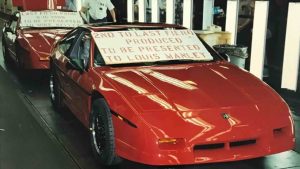
Perhaps saddest aspect of the Fiero’s short life is that shortly after GM decided the Fiero had no future, Mazda brought out the Miata – a fun and very affordable little roadster that was everything the Fiero might have been – and almost was. That’s the tragic element underlying the story of this car.
The Fiero could have evolved into one of the world’s greatest affordable sports cars. It had many of the right ingredients – from its mid-engined layout to its American Ferrari styling.
But it was pushed into an early grave by short-sighted management decisions that fatally compromised the car before the first one was ever sold.
. . .
Nutz & Boltz:
-
- Like the Corvair, the Fiero originally lacked power steering – which was deemed unnecessary since the front end of the car was light due to the mid-engined layout.
- The Fiero was the last two-seater Pontiac made and the only one made since the 1926-1938 coupes.
- Models equipped with the standard manual transmission and a 0.73 top gear were very fuel efficient, capable of returning more than 50 miles per gallon on the highway. But those equipped with the optional three speed automatic were much thirstier, probably because the automatic had only three gears and no overdrive gearing.
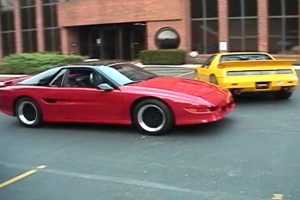
- Hulki Aldikacti lobbied for an aluminum V6 but developing an all-new engine specifically for the car would have cost more than the entire $400 million budget GM allotted to develop the car, itself.
- “Fiero” was ultimately chosen as the name for the car after a number of others – including Pegasus, Fiamma and Sunfire were rejected. The latter name was eventually used as the name for Pontiac’s version of the Chevy Cavalier.
- At first, Pontiac limited available color choices to red, white, black and light gray metallic, apparently because Pontiac’s paint shop couldn’t handle more than these four colors at first. It may also have had to do with the car’s plastic body panels, which required different prep work for the color to bond properly and to assure uniformity.
- Pontiac offered a WS-6 ride and handling package that was similar to the mix of suspension/wheel-tire upgrades that were first offered with the second generation (1970-1981) Trans-Am. It included larger diameter anti-sway bars, firmer suspension calibrations and light-alloy “lattice” wheels with Goodyear high-perofrmance Eagle GT tires.
- The prototype for what might have been the second-generation Fiero was finally revealed to the public in 2003, fifteen years after the Fiero’s cancellation. This car was to have been powered by a version of the then-new Quad 4 DOHC engine – reportedly in the 200 hp range. But the most tantalizing possibility was the 3.8 liter V6, which was used in several late-’80s tire-fryers – including the Buick Regal Gran National and the 1989 20th Anniversary Trans-Am. In those cars, the V6 developed nearly 300 turbocharged horsepower. In the much lighter-than-those cars Fiero, performance would have been even better – which (again) probably accounts for why it never came to pass.
Excerpted from the forthcoming (soon!) book, Doomed.
. . . .
Got a question about cars, Libertarian politics – or anything else? Click on the “ask Eric” link and send ’em in! Or email me at [email protected] if the @!** “ask Eric” button doesn’t work!
If you like what you’ve found here please consider supporting EPautos.
We depend on you to keep the wheels turning!
Our donate button is here.
If you prefer not to use PayPal, our mailing address is:
EPautos
721 Hummingbird Lane SE
Copper Hill, VA 24079
PS: Get an EPautos magnet or sticker or coaster in return for a $20 or more one-time donation or a $10 or more monthly recurring donation. (Please be sure to tell us you want a magnet or sticker or coaster – and also, provide an address, so we know where to mail the thing!)
My eBook about car buying (new and used) is also available for your favorite price – free! Click here. If that fails, email me at [email protected] and I will send you a copy directly!


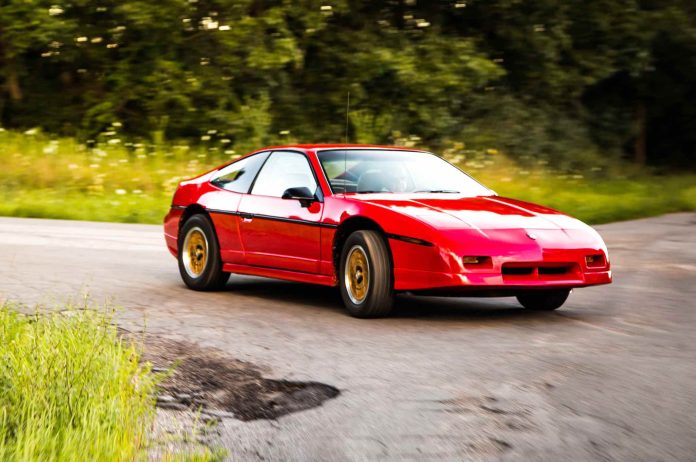









The handwriting was on the wall when GM divested itself of General Motors Institute (GMI) in 1982. GMI turned out a couple hundred engineers tuned especially to the auto industry each year due the cooperative-education nature of the school. Students worked in GM plants, generally in many aspects of design or production before graduating. They saw the business from the ground up and experienced many engineering insights before hanging the degree on the wall. And for most of the life of GMI the primary business of GM was building cars.
The bean-counters were winning the top spots in GM management. Ross Perot was famous (infamous) for pointing it out, but it was obvious well before he spoke about the disaster-in-the-making.
I suppose Kettering University, the current embodiment of GMI is still a leader in several fields. But GMI did its thing without letting “Public Policy” intrude in engineering education. For a period in history, GMI was the King of the Hill (at least at Chevrolet and 3rd in Flint). I am certain “Boss” Kettering would be most unhappy with the way things have become, even with the honor of a namesake university. Besides that, his most famous invention is becoming obsolete since EVs have no starters.
In the late 80s/early 90s I remember the manager of one of our restaurants had one of these. The guy also had a carphone in it (infact I think it was the first time I used one). He was also a black belt in Karate and used to arrange tournaments – one of the coolest guys we 3 brothers ever knew, and wanted to be like him (ofcourse this is before health and safety so we brothers used to actually help out in the restaurant when we could)….. Maybe its just me, but I just cant imagine today a guy who manages a restaurant having a cool sports car….
And as a 33yo man, I reminisce about those days, when young folks had sports cars instead of SUVs/Crossovers.
I remember the days when you’d see people around my age (10yrs give or take) with coupes and convertibles, then it seemed everyone wanted to be “Practical”, which lead to crossovers taking over.
Now if anyone has a sports car, you know who they are, as they stand out when everyone else blends in
Auto debt bubble……
Kyle Bass Says China’s Banks Insolvent, Plus Serious Problems For US Consumers As Auto Bubble Bursts
Barron’s over the weekend had an important article written by Lisa Beilfuss titled “Car Repos Are Exploding. That’s a Bad Omen” and with a contribution from Danielle Dimartino Booth, the CEO of Quill Intelligence.
Lisa reports:
“Lucky Lopez is a car dealer who has been in the business for about 20 years. In recent meetings with bankers, where he bids on repossessed vehicles before they go to auction, he has noticed some common characteristics of the defaulted loans.
Most of the loans on recently repossessed cars originated during 2020 and 2021, whereas origination dates are normally scattered because people fall on hard times at different times; loan to value ratios…are around 140%, versus a more normal 80%; and many of the loans were extended to buyers who had temporary pops in income during the pandemic.”
I say, 140%!
With the help of PPP money, debt forbearance, stimulus checks and extra unemployment benefits, many bought ‘too much’ car at the same time “Banks’ auto lending standards…went out the window, and then lenders jumped on the bandwagon of overpaying for cars”, Lopez says. “Everybody thought the free gravy train would never end,”
Lopez says. Lisa went on, “Now, he (Lopez) he says he has never seen so many people making $2,500 a month owning $1,000 a month in car payments. That’s about double the maximum portion of income many financial advisors recommend allocating toward a car payment.” His bottom line, “We had a housing bubble in 2008, and now we have an auto bubble.”
Danielle pointed out that banks are “buying car lots to handle the flood of repossessed, used cars coming to the market.” What’s the banks’ exposure? On those 140% LTV loans they are getting around 70% at auction. There was a total of almost $1.5T auto debt outstanding as of the end of Q1.
https://kingworldnews.com/kyle-bass-says-chinas-banks-insolvent-plus-serious-problems-for-us-consumers-as-auto-bubble-bursts/?fbclid=IwAR0Xv3Swx4kArQ8KGZ_aQo6w2-cJF1W6pIsYCtWOgOrObPL_LYtRg4hgWdg
Owning these older cars will get expensive
Independent car owners to be charged Carbon tax Monthly 8 Year or Older Vehicles – Climate change is the excuse
https://www.youtube.com/watch?v=r76CnjQ6C8M
My first car was an ’86 Fiero SE V6 2.8L automatic that I bought in ’98 for I think $1800 or something. It was a fun little car for a guy in highschool. It was underpowered, needed more gears, and a better suspension though as Eric already alluded to. I replaced it with a ’94 Z28 after a while though since it kept breaking down.
It’s unfortunate that Pontiac was never allowed to really make the Fiero the way it should have been. The idea definitely had potential.
More proof that any good idea can be wrecked by management.
GM protecting their “premier” sports car instead of making it better.
You might appreciate this- Fiero with Caddy 4.9 and Eaton blower…
https://youtu.be/XD6qn_tIhsQ
In 1988 I was 27 yo and I wanted a Fireo GT 5sp some kinda bad…….Land and a house won out out.. At lease I still have the house.
“The Fiero was the last two-seater Pontiac made and the only one made since the 1926-1938 coupes.”
What about the Solstice?
https://en.wikipedia.org/wiki/Pontiac_Solstice
Hi William,
Technically, yes – but the Solstice was just a rebadged Saturn Sky; the Fiero was a legitimate Pontiac in that it wasn’t a rebadged somebody else’s car and it had a Pontiac-designed engine (base four).
I hadn’t given the Fiero any thought since the 80’s until the Breaking Bad character ‘Badger’ appeared on the show.
Delorean on GM…….
The DeLorean Motor Company name was subsequently purchased by a Texas-based firm that provides parts and professional restoration to DeLorean owners. Although John DeLorean was not involved in the business, its vice president James Espey spoke with him on the phone once a month. According to Espey, in their final conversation,
DeLorean expressed his dismay at the direction of General Motors, saying “They have too many bean counters and not enough engineers.”
Then there is Porsche lots of the world’s best engineers, it makes a difference…..
“They have too many bean counters and not enough engineers”-anon.
I think that disease afflicts most companies these days, take a good product and turn it to crap to make a bigger profit for the executives.
Typical General Motors. Push exciting car out onto the market before it’s ready with good sales numbers initially and then a steep drop-off when the public realizes they’ve been sold more low-quality GM penny-pinching. The problems are corrected, the car becomes what it should’ve been from the get-go and then GM pulls the plug.
Rinse and repeat. They did it with the SSR convertible truck. The Corvair. The Cadillac XLR and Allante.
Shame of it is GM has some great engineers hamstrung by bad management. The cars built on the Alpha rear wheel drive platform (ATS and Camaro) are some of the best handling cars on the planet. The latest small block V-8s and the “high-feature” DOHC V-6s are both wonderful engines.
Now management is committing suicide by going over the cliff with all of the other automakers in the quest for electrification.
When your name is Government Motors, no one expects good decisions, especially when their current CEO is a woman who day dreams about being in Sex and the City
I pray all this EV/CAFE shit ends someday…
Eric,
After the Fiero hit the market, Toyota brought out their MR2. The MR2 was a good selling car, having lasted two generations. It was what the Pontiac Fiero SHOULD have been! The fact that Toyota was able to sell two generations’ worth of the car is proof that Pontiac’s concept worked; it proved that there was a market for the car. How could GM management have missed this?
Also, my buddy Bob had a Fiero for a while. It had the stick shift and the 4 cylinder engine in it. I don’t know about the suspension it had, but I know this: it handled like it was ON RAILS! There’s a hairpin turn in Pt. Pleasant Beach, NJ, and Bob’s Fiero went around it like it was a slot car…
Hi MM
I’ve heard that the MR2 design originated from Lotus and Delorean but because of their owner’s legal hassles (money disappearing, etc.), Toyota ended up with the design and built it. More GM Delorean connections.
When Toyota built the MR2 Lotus and Toyota were working on designs together. During this time Toyota had bought into Lotus as a means of gaining performance and small production run knowledge. Later on GM bought Lotus.
There are two rumors about Lotus’ involvement with the MR2. The “official” rumor is that the MR2 was designed “in-house” at Toyota by Lotus suspension engineer Roger Becker.
The other rumor is that the MR2 was an abandoned Lotus design (possibly the M90/X100). According to Doc Bundy, Lotusport Esprit driver, the MR2 is the X100.
Lotus Cars was founded and owned for many years by Colin Chapman. After his death and a period of financial instability, Toyota had a part ownership then it was bought by General Motors, then Romano Artioli (Italian), and DRB-HICOM (Malaysian) bought it through its subsidiary Proton.
It is currently owned by Chinese multinational Geely, it soon will only make 4000 lb, lithium fire bomb battery EV’s, another one down the tube….lol
General Motors: A bank run by accountants, masquerading as a car company.
A guy I knew had a Fiero GT with V6 and manual trans. At the same time I had an 88 Mustang GT. His car was every bit as fast, and better handling then mine.
Hi Tom,
The Fiero’s a car I’ve always wanted to own. I’d be happy with a four cylinder/manual version – though of course the ’88 with the V6 and five speed/revised suspension is the most desirable version. I miss fun cars like this so much…
Hi Eric
Another GM great idea here…
The Hummer EV story:
What they wanted:
The target fuel economy EV manufacturers are trying to get is to get 3.6 mile range for every kwh or using 27.77 kwh to go 100 miles (.2777 kwh per mile) = 125 mpg
125 mpg is based on electricity just coming out of a wall plug, in reality 3.20 gallons of fuel were burnt to generate the electricity in the power station). = 31.25 mpg
What they got:
What test drivers are actually getting driving in the real world driving EV’s is they are getting 2.4 miles of range for every kwh or using 41.66 kwh to go 100 miles. (.4166 kwh per mile) = 83 mpg
(83 mpg is based on electricity just coming out of a wall plug, in reality 4.80 gallons of fuel were burnt to generate the electricity in the power station = 20.8 mpg).
So to end up with 41.66 kwh of electricity which is equivalent to 1.20 gallons of gas to push the EV 100 miles down the road 4.80 gallons of fuel were burnt to generate the electricity in the power station, remember net 25% efficiency. 100 miles using 4.80 gallons = 20.8 mpg,
20.8 mpg….lol…..these EV’s use more fuel so pollute more then ice vehicles
ATTENTION: What they got in the Hummer EV:
Based on it’s highway rating of 43 mpg….. they are getting 1.23 miles of range for every kwh or using 80.69 kwh to go 100 miles. = 43 mpg = 2.32 gallons of gas to go 100 miles.
(43 mpg = 2.32 gallons of gas, is based on electricity just coming out of a wall plug, in reality 9.30 gallons of fuel were burnt to generate the electricity in the power station = 10.75 mpg).
So the the Hummer EV gets 10.75 mpg…lol…
Lots of lies in the EV push agenda
So there is a big difference between using 2.32 gallons to go 100 miles and using 9.30 gallons, it doesn’t matter, tax payers can pay for it through the government owned power station…lol… why should the EV driver pay?
most new gas or diesel ice cars get better fuel economy, cost way less, use far fewer resources to manufacture, don’t have lithium fire bomb batteries, last three times as long as EV’s….
NOTE:
40% of electricity in the U.S. comes from coal so the Hummer runs on coal…lol
Thermal efficiency of power plants using coal, petroleum, natural gas or nuclear fuel and converting it to electricity are around 33% efficiency, natural gas is around 40%. Then there is average 6% loss in transmission, then there is a 5% loss in the charger, another 5% loss in the inverter, the electric motor is 90% efficient so another 10% loss before turning the electricity into mechanical power at the wheels.
33% – 6% – 5% – 5% – 10% = 25% efficiency for EV’s. In very cold weather EV’s are 12% efficient
NOTE: 34.7 kwh of electricity is equivalent to 1.02 gallons of gas
Plus the cost of the battery, which is huge, you have to store the electricity in the very, very expensive battery, that is the killer for EV’s right there, the expensive, rapidly wearing out battery.
the tesla $22,000 battery is used up, worn out in 100,000 miles. this works out to $22.00 per 100 miles it is costing you for the battery.